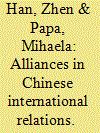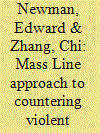|
|
|
Sort Order |
|
|
|
Items / Page
|
|
|
|
|
|
|
| Srl | Item |
| 1 |
ID:
179948


|
|
|
|
|
| Summary/Abstract |
What are Chinese views of international security alliances? Some scholars argue that the idea of alliance formation has become obsolete in contemporary international relations (IR), while others predict that China will eventually return to alliance formation, as major power competition intensifies. This study analyzes 1,403 articles addressing China’s foreign relationships published in the top five Chinese IR/political science journals between 1990 and 2019. We use automatic content analysis to identify key concepts and measure trends in Chinese alliance thinking. Our findings challenge the view that alliances are obsolete in contemporary Chinese IR. Alliance debates have increased in prominence during Xi’s administration. Since the 1990s, however, the partnership concept has emerged as an alternative to the alliance concept. We examine the application of these concepts through cases of China’s relations with the United States, Russia, and India.
|
|
|
|
|
|
|
|
|
|
|
|
|
|
|
|
| 2 |
ID:
179952


|
|
|
|
|
| Summary/Abstract |
Since the 2000s, Russia intensified its relations with the Central Asia. This is particularly visible in the increased institutionalization of the cooperation. This paper argues that regional regimes like the Collective Security Treaty Organization (CSTO) and the Eurasian Economic Union (EEU) became the prime tools in Russia’s cooperative hegemony in the Central Asia. This strategy relies on co-opting of the smaller partners into institutional settings for the purpose of not just enhancing cooperation but also reestablishing a softer form of domination over the region and transforming it into a regional pole. This in turn would be a foundation for Russia’s return to the global stage. As the paper shows, this strategy relies on would-be hegemon’s ability to convince a sufficient number of regional partners to seek membership in these regimes, share the power with them, and remain committed to the project.
|
|
|
|
|
|
|
|
|
|
|
|
|
|
|
|
| 3 |
ID:
179951


|
|
|
|
|
| Summary/Abstract |
Since the launch of the Maritime Silk Road Initiative (MSRI), observers have witnessed the consolidation of a growing Chinese presence in ports around the Indian Ocean Region (IOR). This growing presence has caused alarm among skeptics who view the MSRI as a second coming of the String of Pearls (SoP). Indeed, China is seen as leveraging MSRI port investments in return for national strategic and geopolitical gain, such as ultimately gaining a military foothold in MSRI ports. Regardless of China’s purported intent, this paper seeks to add nuance to this debate by examining whether Beijing can actually achieve such strategic gains in the IOR via the deployment of its economic statecraft (via MSRI investments). As the paper shows, the MSRI’s current rollout – as well as the inherent resistance to the strategic dimensions of this rollout – offer little in the way of empirical support to the SoP concept.
|
|
|
|
|
|
|
|
|
|
|
|
|
|
|
|
| 4 |
ID:
179950


|
|
|
|
|
| Summary/Abstract |
President Donald Trump’s “America First” policy questions the fundamentals of the global U.S.-led alliance network. Where other allies implemented hedging strategies, Japan’s Prime Minister Abe Shinzō pledged to “make the alliance even greater,” insisting that the bilateral ties were “airtight” and “stronger than ever before.” However, Trump’s approach to trade, détente with North Korea, and off-the-cuff remarks regarding nuclear weapons invigorated criticism in Japan: the U.S. is an unreliable partner and Japan needs to prepare for life after the alliance. We argue that Abe’s embrace of Trump was successful in staving off the worst, maintaining stability at the cost of personal humiliation and certain trade and security interests. However, Trump’s cavalier treatment of Japan has laid bare the realities of the alliance, potentially revitalizing a more autonomous discourse of alternatives to the current and often “humiliating” modus in alliance management.
|
|
|
|
|
|
|
|
|
|
|
|
|
|
|
|
| 5 |
ID:
179953


|
|
|
|
|
| Summary/Abstract |
As a strategy to temper centralized governance with a degree of public participation in China, the “Mass Line” approach has been used throughout the history of the Chinese Communist Party (CCP) to mobilize citizens in support of national projects and use this engagement as a channel for feedback. The Mass Line has been employed in attempts to address “radicalization” and challenges to centralized state control, indicating that the CCP’s approach to counter-terrorism goes beyond the top-down, oppressive tactics that China is often associated with. This paper explores China’s programmes of mass mobilization as a part of its counter-radicalization strategy in order to deepen understanding of how the country is responding to a key security challenge. It demonstrates that this approach reflects significant historical continuities, and thus national characteristics, in terms of political culture and state control.
|
|
|
|
|
|
|
|
|
|
|
|
|
|
|
|
| 6 |
ID:
179947


|
|
|
|
|
| Summary/Abstract |
China’s capabilities and prestige in the Sui and Tang dynasties (581–907) were stronger than the Koguryo Kingdom, but Koguryo resisted China’s tributary system more than other countries during 598–668. This article unpacks the unique role of the tributary system within Chinese foreign policy toward Koguryo, and it shows how the symbolic concept of political prestige affected China’s decisions to go to war against Koguryo during the Sui and Tang dynasties. It highlights the role of status and legitimacy that the Chinese emperors attached to China’s tributary systems, and argues that these status concerns, rather than the material factors emphasized by offensive realism and defensive realism, drove Chinese behavior. China’s capabilities were rising compared to those of the Koguryo kingdom, so there were no incentives for preventive war, and political discourse among China’s political elites showed great concern over status. Their justifications of military expeditions and heated debates in the Chinese court provide strong evidence illustrating this consistent struggle to reclaim supremacy in Northeastern Asia. The finding of the study indicates that Asian history should not simply be treated as empirical data to test Western international relations (IR) theory; rather, Asian history can contribute to theory building in IR.
|
|
|
|
|
|
|
|
|
|
|
|
|
|
|
|
| 7 |
ID:
179949


|
|
|
|
|
| Summary/Abstract |
Australia and Indonesia are two very different countries with little in common other than geography. Their distinctive histories, cultures and identities have meant that the bilateral relationship has often been difficult and characterized by frequent misunderstandings and uncertainty. As close neighbors, however, they have had little option other than to try to make the best of their historical circumstances. This paper analyses the different strategic cultures, policies and perspectives that have emerged in both countries. We argue that despite their differences, the current international order offers an opportunity for “middle powers” to play a more prominent role – if they can recognize their mutual interests and potential as members of a region of growing international importance.
|
|
|
|
|
|
|
|
|
|
|
|
|
|
|
|
|
|
|
|
|